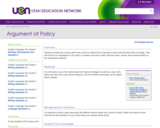
These explanations are linked to mythological allusions present in "The Rose of Versailles" manga. Source material is provided. RL.9-10.9 alllusions to other works.
- Subject:
- Arts
- English Language Arts
- Material Type:
- Reading
- Date Added:
- 12/01/2023


These explanations are linked to mythological allusions present in "The Rose of Versailles" manga. Source material is provided. RL.9-10.9 alllusions to other works.

Practice matching antonyms, synonyms, and homonyms, with Word Frog, an animated self-scoring activity, with three different levels of difficulty.

This resource offers a quick explanation of how to use the ellipsis correctly.

In this lesson, students will learn the importance of citing text evidence to build an argument essay.

Students will discover a policy within their school or district that is important to them and that they'd like to change. They will conduct an investigation of the policy in question and write a letter with their claim, results, and recommendation to the appropriate audience.

Young children love to help with grown-up tasks so they'll really enjoy making this alphabetical shopping list, in this activity from Arthur.

This collection foster students' interest in reading and writing, and encourage positive social skills with this collection of classroom resources from ARTHUR. Aimed at children between the ages of four and eight, these resources feature entertaining and educational activities for use at and away from the computer. (In This Collection: Document (124), Video (14), Lesson Plan (1), Interactive (6), Media Gallery (1) for Grades K-2, 3-5, PreK-K.

This interactive site gives examples of how to write a letter, an email, a postcard, and a greeting card. It even explains how to address an envelope. As students roll their mouse over the letter it explains what each part is called and why it is there.

What is an article? Explore the world of articles when you visit this informative resource. Students and teachers can brush up on their knowledge of these tiny but important words.

This site is an analysis of rhythm, imitation, style, tone, and technique of poetry. References to imagists and their works are also included
![ArtsNow Learning: Adventure Island [PDF]](https://openspace.infohio.org/static/newdesign/images/materials/default-thumbnail-index.png)
In this lesson, students will study examples of treasure maps and make a list of features and symbols. They will use their imaginations to create their own treasure maps and compose narratives to describe them.
![ArtsNow Learning: Carnival of the Animals [PDF]](https://openspace.infohio.org/static/newdesign/images/materials/default-thumbnail-index.png)
Students will expand knowledge about music vocabulary through exploration of The Carnival of the Animals, composed by Camille Saint-Sains. Students will be able to use key music terms in discussions with their peers and in persuasive writing.
![ArtsNow Learning: Character Choreography [PDF]](https://openspace.infohio.org/static/newdesign/images/materials/default-thumbnail-index.png)
In this lesson, portraits provide inspiration for students to create character descriptions. Then, basic dance techniques are used to express the traits, motivations, and feelings of the characters as students work collaboratively to make a character come to life through movement.
![ArtsNow Learning: Creating a Role Drama to Analyze Characters in a Text [PDF]](https://openspace.infohio.org/static/newdesign/images/materials/default-thumbnail-index.png)
Students will use drama to analyze characters in the text A Bad Case of Stripes by David Shannon. After an interactive read-aloud of the text, students will take on roles of characters in the story. They will step into a role drama where they analyze the major problem present in the story and present possible solutions. Students will then independently write their own ending to the story, followed by discussion and reflection.
![ArtsNow Learning: Dancing Differences [PDF]](https://openspace.infohio.org/static/newdesign/images/materials/default-thumbnail-index.png)
This activity will allow students to explore comparing and contrasting through movement and choreographic sequences.
![ArtsNow Learning: Dr. Seuss Is on the Loose [PDF]](https://openspace.infohio.org/static/newdesign/images/materials/default-thumbnail-index.png)
The rhythmic and melodic elements of Theodor Geisel's children's literature provide many opportunities for knowledge of language, vocabulary acquisition and use, and creative expression and communication in music. Students work with two books in this lesson - Dr. Seuss's ABC and P.D. Eastman's Go, Dog. Go!
![ArtsNow Learning: Explore the Writing Process Through Painting [PDF]](https://openspace.infohio.org/static/newdesign/images/materials/default-thumbnail-index.png)
In this lesson, students imagine their dream destination spots and sketch them. They use basic watercolor painting techniques to paint their images and follow this by writing descriptions. In groups, they then compile a sequential narrative story with all their images.
![ArtsNow Learning: Exploring Adjectives Through Art and Creative Writing [PDF]](https://openspace.infohio.org/static/newdesign/images/materials/default-thumbnail-index.png)
In this lesson, students will use adjectives to describe artwork and to develop descriptive language in creating interesting and unique stories.
![ArtsNow Learning: Exploring Social Studies Through Playwriting [PDF]](https://openspace.infohio.org/static/newdesign/images/materials/default-thumbnail-index.png)
In this lesson, students use photos of people in real-life events from the Zapatistas Movement as a springboard to write a dialogue between the people in the photograph. Students then work in pairs to create a scene that addresses the issues surrounding the Zapatistas Movement.
![ArtsNow Learning: Mona Mesa: What is Your Opinion? [PDF]](https://openspace.infohio.org/static/newdesign/images/materials/default-thumbnail-index.png)
In this lesson, students look at a print of "Mona Lisa" by Leonardo DaVinci and talk about what they see, searching for visual clues to help them form an opinion. They discuss the importance of portrait paintings during the Renaissance era, as well as in this era. Students will then visually portray themselves in the body of Mona Lisa, thus creating a self-portrait, Mona MEsa!